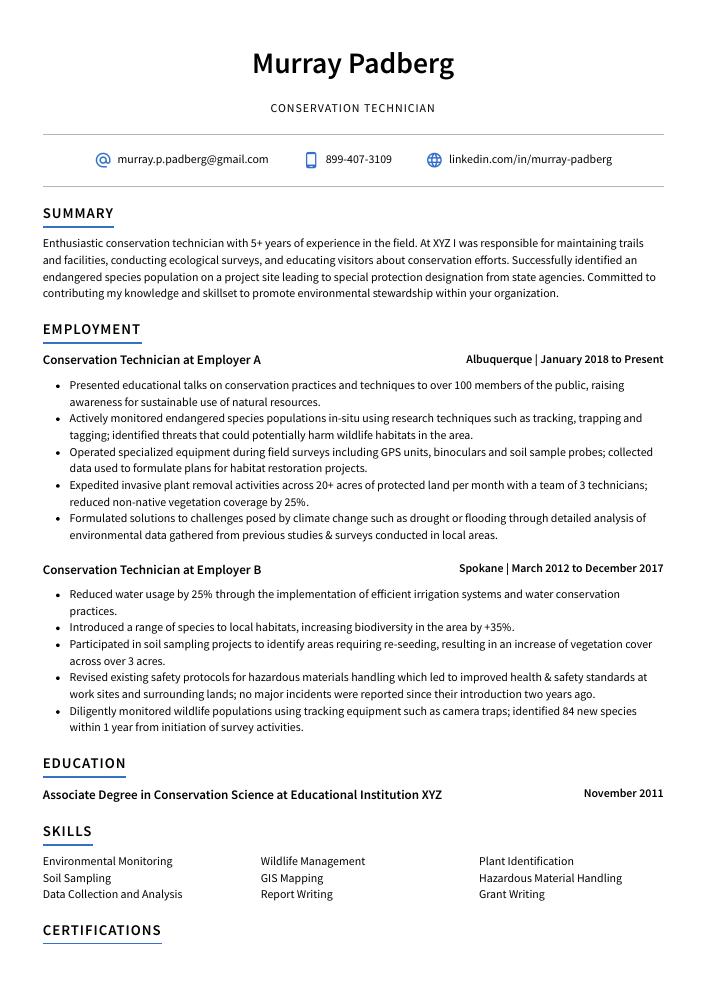Conservation Technician Resume Guide
Conservation Technicians are responsible for maintaining and restoring natural resources. They conduct surveys to assess the health of ecosystems, monitor wildlife populations, control invasive species, and manage land use activities. Additionally, they often provide educational programs about conservation topics to local communities.
Your knowledge of environmental conservation and sustainability is unparalleled. However, potential employers don’t know who you are yet – to make them aware of your abilities, you must write a resume that stands out from the rest.
This guide will walk you through the entire process of creating a top-notch resume. We first show you a complete example and then break down what each resume section should look like.
Table of Contents
The guide is divided into sections for your convenience. You can read it from beginning to end or use the table of contents below to jump to a specific part.
Conservation Technician Resume Sample
Murray Padberg
Conservation Technician
[email protected]
899-407-3109
linkedin.com/in/murray-padberg
Summary
Enthusiastic conservation technician with 5+ years of experience in the field. At XYZ I was responsible for maintaining trails and facilities, conducting ecological surveys, and educating visitors about conservation efforts. Successfully identified an endangered species population on a project site leading to special protection designation from state agencies. Committed to contributing my knowledge and skillset to promote environmental stewardship within your organization.
Experience
Conservation Technician, Employer A
Albuquerque, Jan 2018 – Present
- Presented educational talks on conservation practices and techniques to over 100 members of the public, raising awareness for sustainable use of natural resources.
- Actively monitored endangered species populations in-situ using research techniques such as tracking, trapping and tagging; identified threats that could potentially harm wildlife habitats in the area.
- Operated specialized equipment during field surveys including GPS units, binoculars and soil sample probes; collected data used to formulate plans for habitat restoration projects.
- Expedited invasive plant removal activities across 20+ acres of protected land per month with a team of 3 technicians; reduced non-native vegetation coverage by 25%.
- Formulated solutions to challenges posed by climate change such as drought or flooding through detailed analysis of environmental data gathered from previous studies & surveys conducted in local areas.
Conservation Technician, Employer B
Spokane, Mar 2012 – Dec 2017
- Reduced water usage by 25% through the implementation of efficient irrigation systems and water conservation practices.
- Introduced a range of species to local habitats, increasing biodiversity in the area by +35%.
- Participated in soil sampling projects to identify areas requiring re-seeding, resulting in an increase of vegetation cover across over 3 acres.
- Revised existing safety protocols for hazardous materials handling which led to improved health & safety standards at work sites and surrounding lands; no major incidents were reported since their introduction two years ago.
- Diligently monitored wildlife populations using tracking equipment such as camera traps; identified 84 new species within 1 year from initiation of survey activities.
Skills
- Environmental Monitoring
- Wildlife Management
- Plant Identification
- Soil Sampling
- GIS Mapping
- Hazardous Material Handling
- Data Collection and Analysis
- Report Writing
- Grant Writing
Education
Associate Degree in Conservation Science
Educational Institution XYZ
Nov 2011
Certifications
Certified Conservation Technician
Society for Conservation GIS
May 2017
1. Summary / Objective
A resume summary/objective is the first thing a hiring manager will read, so it’s important to make sure yours stands out. For your conservation technician resume, you can use this section to highlight your qualifications and experience in environmental protection and management. You could also mention any certifications or awards you have received related to conservation work, as well as how many years of experience you have in the field.
Below are some resume summary examples:
Passionate conservation technician with a degree in natural resources and 8 years of experience working for the National Park Service. Expertise in wildlife management, habitat protection, ecological monitoring, fire prevention and suppression techniques. Skilled at developing/implementing conservation plans to protect endangered species within their habitats. Committed to preserving our environment for future generations through sustainable development practices.
Determined conservation technician with a passion for protecting natural resources and promoting sustainable practices. 4+ years of experience in environmental research, fieldwork, and data collection projects. Skilled communicator who is adept at coordinating between stakeholders to ensure effective conservation strategies are implemented on-time and within budget. Seeking to join ABC’s Conservation Team to use expertise in preserving local wildlife habitats.
Seasoned conservation technician with 10+ years of experience in conservation and restoration projects. At XYZ, successfully completed over 200 assignments protecting the environment from harmful pollutants. Skilled at using equipment such as pumps, probes, and tanks to collect environmental data for analysis. Excellent communication skills for providing technical guidance to management on various compliance standards and regulations.
Hard-working conservation technician with 5+ years of experience in the field. Experienced in building and restoring natural habitats, conducting environmental assessments, and educating community members on conservation topics. At XYZ Park Service, performed an extensive habitat restoration project that resulted in a 20% decrease in erosion rates over two years. Committed to helping preserve our environment for future generations.
Well-rounded conservation technician with 4+ years of experience in land management, ecological restoration and environmental monitoring. Skilled at leading teams to complete conservation projects on time and within budget. Committed to preserving natural resources while providing excellent customer service. Seeking a challenging role at ABC where I can impact the environment positively by utilizing my knowledge and skillset.
Amicable and experienced conservation technician with 5+ years of experience in restoring and protecting natural habitats. Seeking to join ABC’s team as a Conservation Technician and use my knowledge in ecology, hydrology, soils science, GIS mapping, and chemical management to help protect the environment. Key accomplishment include creating an educational program that raised awareness on water pollution among 500 students.
Energetic conservation technician with 5+ years of experience in environmental protection and management. Experienced in developing action plans for the conservation of natural resources, as well as monitoring agricultural areas to identify potential threats or risks. Seeking to join ABC Resources to help protect our environment from ecological degradation.
Dependable conservation technician with 3+ years of experience in researching and analyzing environmental data, conducting field surveys, and making recommendations to improve the environment. Seeking to apply expertise towards protecting natural resources at ABC Company. At XYZ Corporation, increased plant diversity on company land by 32%.
2. Experience / Employment
The employment (or experience) section is where you provide details about your work history. This should be written in reverse chronological order, meaning the most recent job is listed first.
When writing this section, it’s best to use bullet points for clarity and ease of reading. You want to include detail when describing what you did; instead of simply saying “Assisted with conservation efforts,” say something like “Conducted weekly surveys of local wildlife populations and habitats, reporting findings back to management.” Doing so shows a potential employer that you have specific skills related to the position they are looking for.
To write effective bullet points, begin with a strong verb or adverb. Industry specific verbs to use are:
- Monitored
- Assessed
- Collected
- Analyzed
- Restored
- Preserved
- Controlled
- Inspected
- Operated
- Constructed
- Managed
- Implemented
- Enforced
- Trained
- Documented
Other general verbs you can use are:
- Achieved
- Advised
- Compiled
- Coordinated
- Demonstrated
- Developed
- Expedited
- Facilitated
- Formulated
- Improved
- Introduced
- Mentored
- Optimized
- Participated
- Prepared
- Presented
- Reduced
- Reorganized
- Represented
- Revised
- Spearheaded
- Streamlined
- Structured
- Utilized
Below are some example bullet points:
- Collected water samples from various bodies of water and conducted tests to determine levels of pH, dissolved oxygen, temperature and other measurements; improved accuracy of readings by 20%.
- Improved efficiency in the conservation process by working with local officials to create action plans that were tailored towards specific ecosystems; reduced project costs by $5,000.
- Advised park rangers on best practices for preserving wildlife and natural habitats while adhering to governmental regulations regarding water quality management and environmental protection standards.
- Constructed new birdhouses across protected areas with teams consisting up to 5 people over a 4 week period, increasing biodiversity within each region’s ecosystem +10%.
- Efficiently managed multiple projects at once according to tight timelines without compromising the quality or sustainability of results achieved; completed all tasks ahead of schedule 95%of the time.
- Structured, implemented and monitored conservation management plans for over 10 hectares of land, increasing natural resource protection by 40%.
- Analyzed environmental data to identify potential threats posed to the region’s wildlife; led habitat restoration projects that enhanced biodiversity in the area.
- Confidently advised landowners on best practice standards for farm-level conservation activities such as water quality monitoring and soil erosion prevention; raised awareness among locals about sustainability initiatives within their community.
- Mentored a team of 8 volunteers in conducting weekly surveys of flora and fauna species at risk, initiating remedial action when necessary which ultimately resulted in an 18% increase in animal populations across study sites.
- Developed collaborative relationships with key stakeholders including local authorities, NGOs & universities to ensure effective implementation of sustainable development policies throughout designated areas leading to increased funding opportunities from regional government bodies worth $25K+.
- Implemented effective conservation techniques to protect and conserve over 25,000 acres of natural resources; increased the land’s overall health by 10% in a single year.
- Controlled the spread of invasive species through targeted removal efforts, reducing their presence on protected lands by 40%.
- Reliably monitored wildlife population trends within designated areas to ensure that animal populations remained at sustainable levels; identified potential risk factors with accuracy and took timely corrective action when necessary.
- Represented organization during public meetings related to nature preservation initiatives and effectively communicated project updates for stakeholders’ understanding and buy-in.
- Managed a team of 8 technicians responsible for gathering data from field sites across 3 states; successfully coordinated crew schedules ensuring projects were completed ahead of deadlines while keeping costs under budget ($25K savings).
- Successfully restored over 500 acres of wetlands and forest habitats by implementing effective soil erosion, vegetation removal and re-vegetation techniques; reduced water contamination levels by 30%.
- Facilitated the relocation of endangered wildlife species to new habitats through careful planning and coordination with state conservation agencies; increased native bird populations in target areas by 25%.
- Restored 10+ miles of streambeds affected by sediment runoff, agricultural pollution or other human activities while ensuring minimal disruption to local ecosystems.
- Enforced regulations on hunting, fishing and harvesting activities within protected lands as part of a team effort to preserve natural resources for future generations; issued over 20 citations for violations each month.
- Demonstrated knowledge in ecological principles when conducting assessments that included surveying land features such as flora & fauna diversity, topography & hydrology conditions within assigned sites.
- Utilized sophisticated technology and equipment to monitor water quality, sediment levels and chemical composition in rivers, lakes and other natural bodies of water.
- Monitored weather patterns regularly to determine potential impacts on conservation efforts; identified over 20 instances where corrective action was necessary due to changes in climate conditions.
- Optimized the use of resources by developing strategies that minimized energy consumption while meeting environmental protection goals; reduced resource usage costs by 15%.
- Substantially improved the health of local ecosystems through initiatives such as habitat restoration projects, invasive species removal activities and reforestation programs resulting in a 30% reduction in pollution levels within 3 months.
- Preserved endangered plant & animal species through careful monitoring of their habitats along with judicious implementation of protective measures; successfully increased population numbers for key wildlife species by 40%.
- Compiled and analyzed data from over 40 environmental studies to develop comprehensive conservation plans that increased land protection by 20%.
- Documented species population growths, habitat changes and water quality levels in the area, identifying areas of concern which needed further investigation or action.
- Spearheaded a successful campaign to reduce local pollution rates; led community meetings with residents where solutions were discussed and implemented, resulting in an 8% decrease in air pollutant emissions within 3 months.
- Achieved significant cost savings for regional conservation efforts through resourceful use of materials such as recycled lumber and non-toxic paints; reduced expenses by $5,000 during a single project season.
- Resourcefully organized volunteer clean-up teams at multiple sites across the region on short notice; successfully removed 2 tons of debris from waterways within 4 hours without affecting natural resources negatively.
- Streamlined conservation and maintenance efforts for 10+ acres of protected forest land, resulting in a 20% decrease in labor costs over the past year.
- Prepared detailed reports on soil composition, tree health and wildlife activity to inform conservation decisions; identified potential habitat destruction threats and recommended appropriate solutions.
- Coordinated with local organizations such as park services and environmental agencies to create comprehensive management plans that increased public access by 30%.
- Assessed existing policies related to forestry work at county level, providing recommendations which led to the successful implementation of updated safety protocols across 5 sites within 6 months period.
- Meticulously documented findings after every survey visit through digital photography and field notes containing precise measurements; generated accurate data sets used for long-term monitoring programs.
- Competently performed routine maintenance, inspections and repairs of conservation equipment such as pumps, valves, pipes and irrigation systems to ensure the safe operation of water resources; reduced mechanical breakdowns by 35%.
- Reorganized existing methods for efficient distribution of water resources in the region; implemented new strategies that led to a 25% reduction in wastage.
- Inspected dams and reservoirs regularly for potential issues with system performance or environmental damage; identified over 100 problems within 3 months which were addressed promptly before they caused any harm.
- Trained 10+ volunteers on proper safety procedures when using heavy machinery around conservation sites; successfully increased worker productivity by 15 hours per week without compromising safety standards.
3. Skills
Skill requirements will differ from one employer to the next; this can easily be ascertained from the job posting. Organization A may require experience with hazardous waste management and Organization B may require knowledge of water quality testing.
It is important to tailor the skills section of your resume for each job you are applying for because many employers use applicant tracking systems that scan resumes for certain keywords before passing them on to a human.
In addition, it is beneficial to elaborate on these skills in other sections such as the summary or experience section. This will give potential employers an understanding of how you have applied your skill set in previous roles and what value you can bring if hired by their organization.
Below is a list of common skills & terms:
- Data Collection and Analysis
- Environmental Monitoring
- GIS Mapping
- Grant Writing
- Hazardous Material Handling
- Plant Identification
- Public Outreach and Education
- Report Writing
- Soil Sampling
- Wildlife Management
4. Education
Adding an education section to a conservation technician resume will depend on how far along you are in your career. If you have just graduated and have no prior experience, mention your education below the objective statement. However, if you’ve been working as a conservation technician for years with plenty of responsibilities to showcase, omitting the education section is perfectly acceptable.
If an education section is included, try to list courses and subjects related directly to the specific position or job title applied for.
Associate Degree in Conservation Science
Educational Institution XYZ
Nov 2011
5. Certifications
Certifications are a great way to demonstrate your expertise in a given field. They show potential employers that you have taken the time and effort to become certified in an area related to the job you are applying for, which can give them confidence that you possess the necessary skillset.
Including certifications on your resume is also beneficial because they provide evidence of professional development courses or other activities that help keep your industry knowledge up-to-date. This will make it easier for hiring managers to recognize how qualified and experienced you are when compared with other applicants.
Certified Conservation Technician
Society for Conservation GIS
May 2017
6. Contact Info
Your name should be the first thing a reader sees when viewing your resume, so ensure its positioning is prominent. Your phone number should be written in the most commonly used format in your country/city/state, and your email address should be professional.
You can also choose to include a link to your LinkedIn profile, personal website, or other online platforms relevant to your industry.
Finally, name your resume file appropriately to help hiring managers; for Murray Padberg, this would be Murray-Padberg-resume.pdf or Murray-Padberg-resume.docx.
7. Cover Letter
Writing a cover letter is a great way to showcase your personality and demonstrate why you are the best candidate for the role. It should be made up of 2 to 4 paragraphs, each one highlighting different skills or experiences that make you suitable for the position.
Cover letters also give recruiters more information about who you are as an individual and how your background makes you highly qualified for this job. Even if it’s not required by most employers, it is worth sending one along with your resume in order to show them what sets you apart from other applicants.
Below is an example cover letter:
Dear Beryl,
I am writing in response to your ad for a Conservation Technician. With experience in natural resource conservation and a passion for the environment, I am confident I would be an asset to your team.
In my current role as Conservation Technician with the Department of Natural Resources, I have gained valuable experience working on various conservation projects. I have assisted with streambank stabilization efforts, invasive species removal projects, and tree planting initiatives. My work has helped to improve water quality and habitat for fish and wildlife in our state.
I am knowledgeable about best practices for natural resource conservation and have experience using a variety of tools and equipment. In addition, I have excellent communication skills that allow me to effectively interact with project stakeholders. My positive attitude and willingness to take on new challenges make me an ideal candidate for this position.
I look forward to speaking with you about how my skills and experience can benefit your organization’s conservation efforts. Thank you for your time and consideration.
Sincerely,
Murray
Conservation Technician Resume Templates
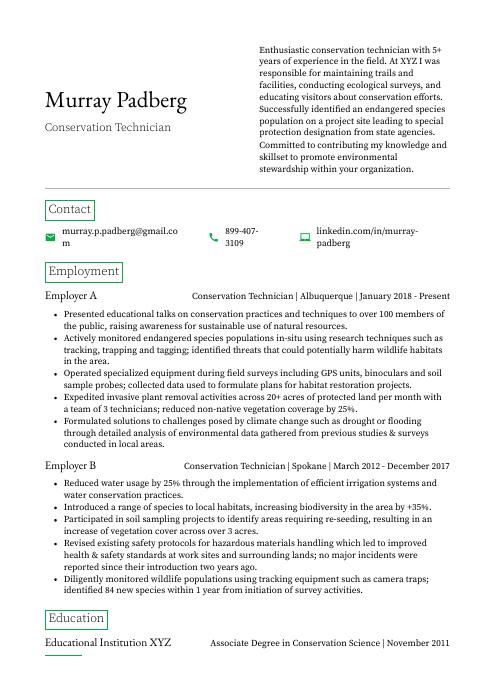 Quokka
Quokka Fossa
Fossa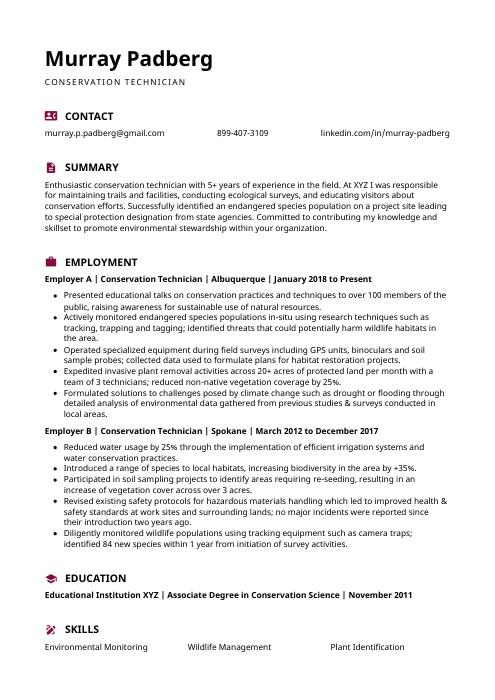 Hoopoe
Hoopoe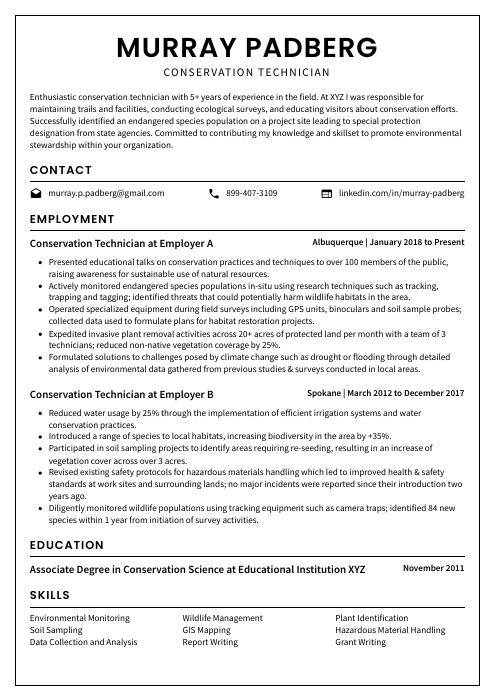 Cormorant
Cormorant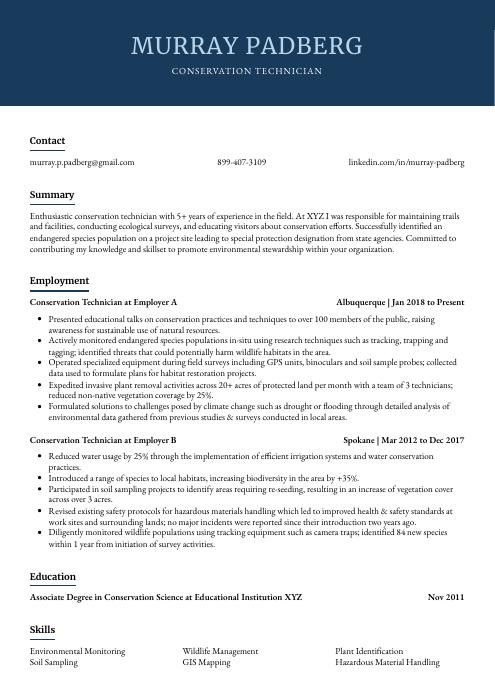 Bonobo
Bonobo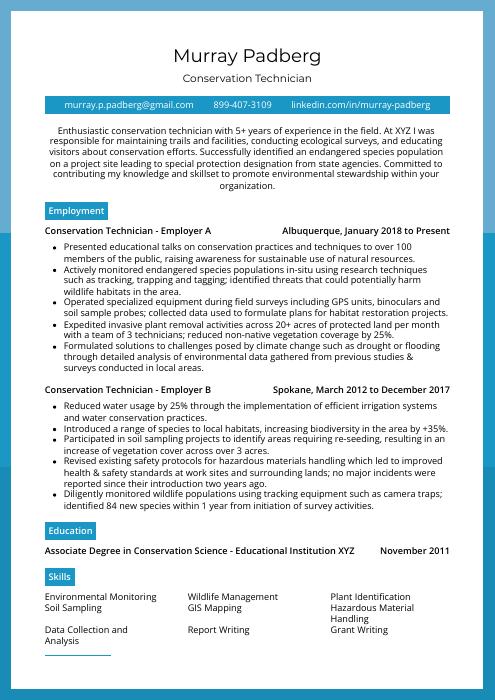 Rhea
Rhea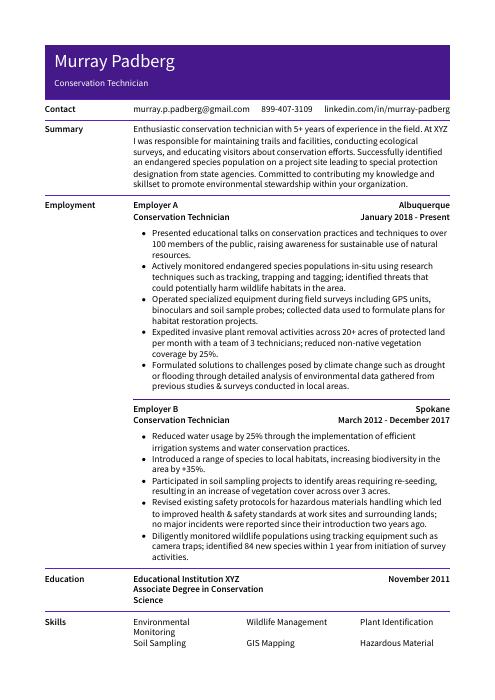 Pika
Pika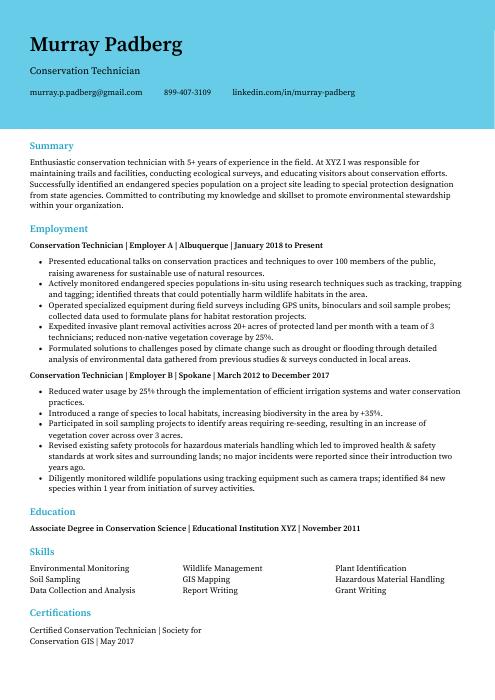 Dugong
Dugong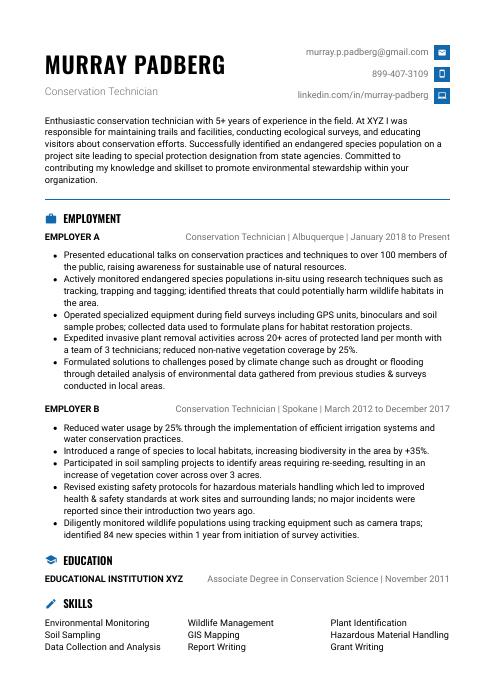 Echidna
Echidna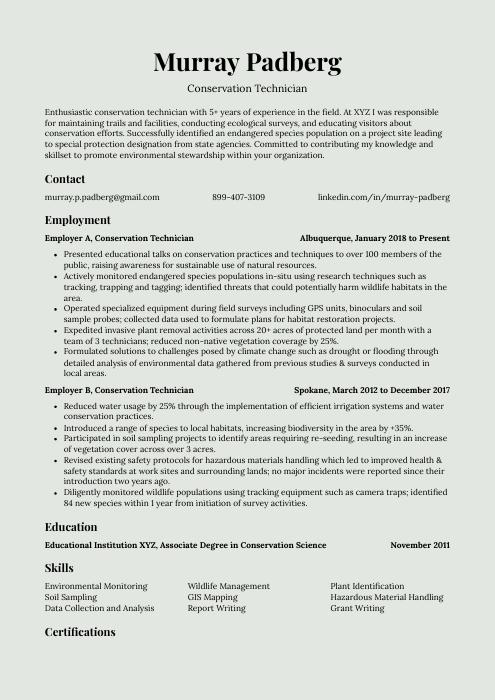 Saola
Saola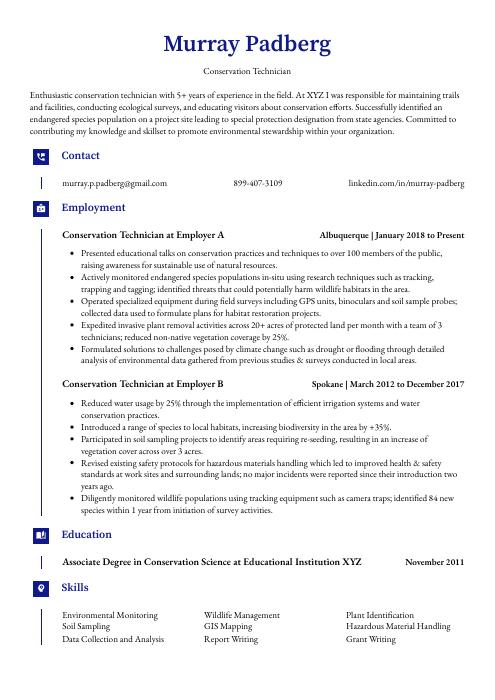 Gharial
Gharial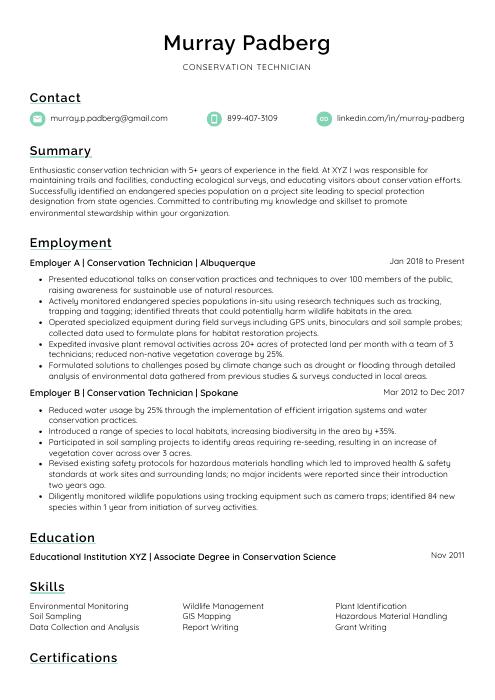 Lorikeet
Lorikeet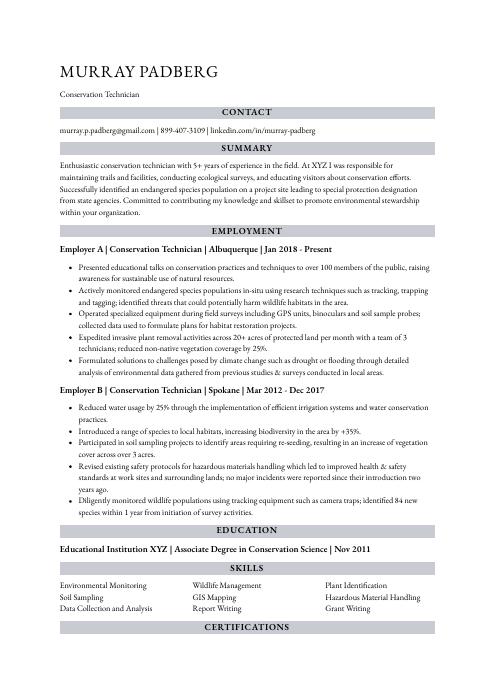 Numbat
Numbat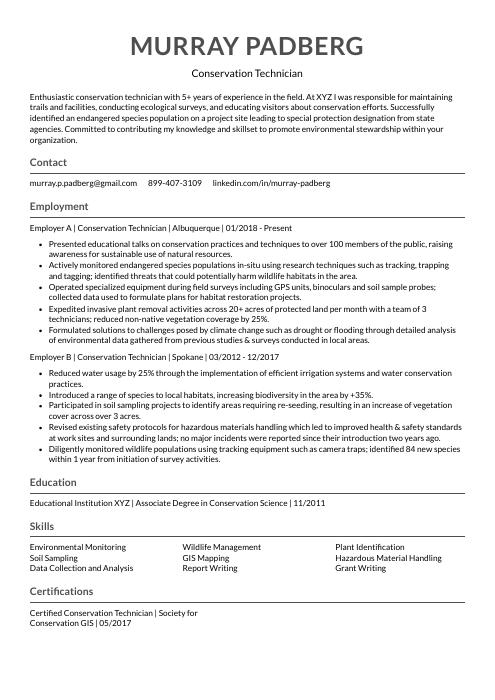 Indri
Indri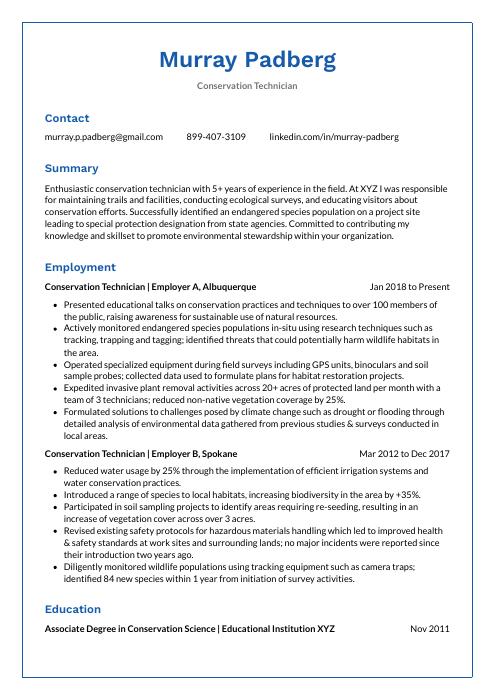 Markhor
Markhor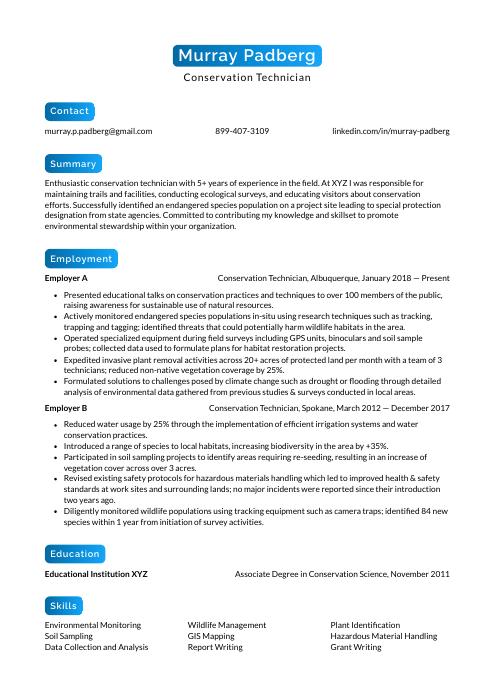 Kinkajou
Kinkajou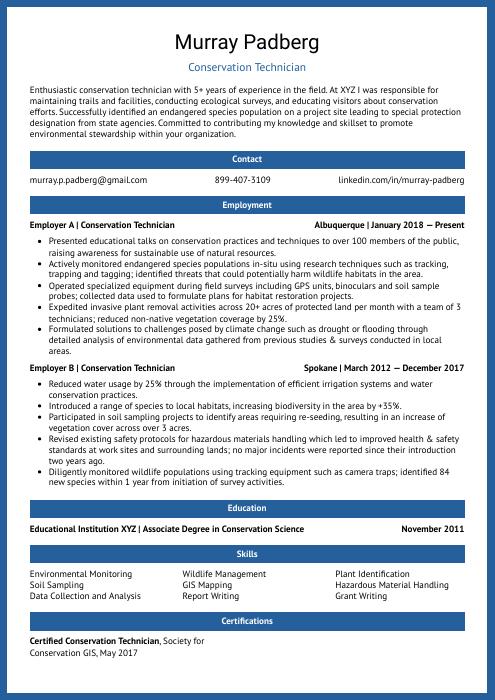 Ocelot
Ocelot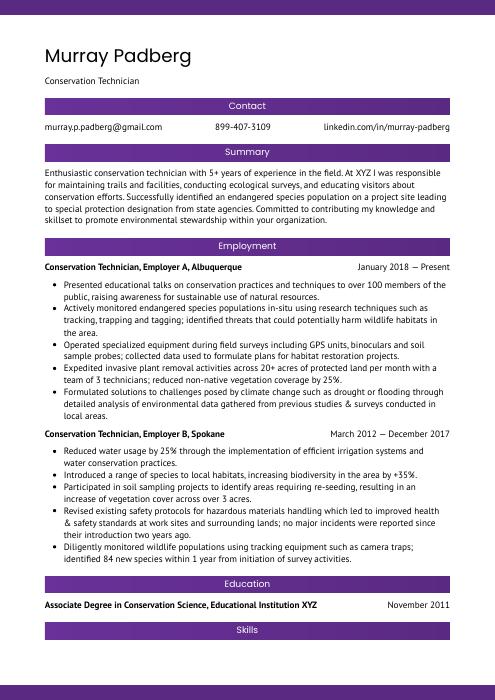 Jerboa
Jerboa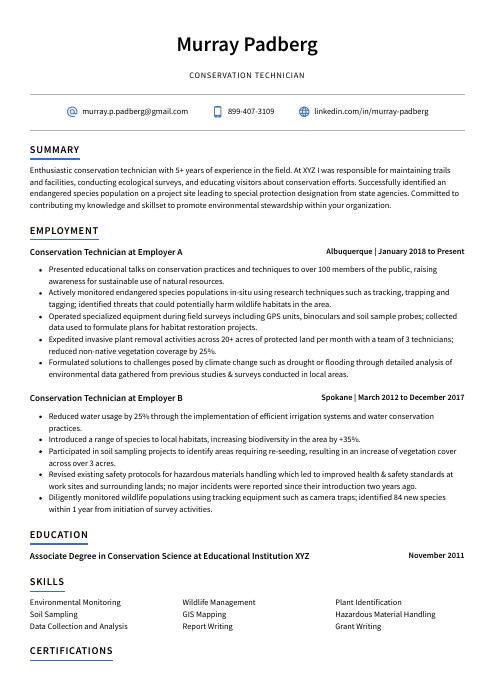 Axolotl
Axolotl Rezjumei
Rezjumei
